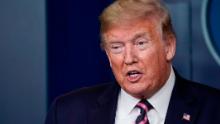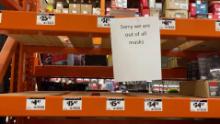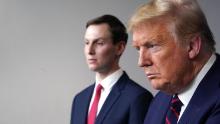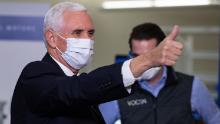[ad_1]
To an extent, the President was right. The Obama administration did use and then failed to replace items from the stockpile to fight the 2009 H1N1 “swine flu” pandemic.
But Trump hadn’t replaced those items either, despite repeated warnings that the country was ill-prepared for a pandemic, stockpile experts said.
The President’s criticism also ignored a key point: The stockpile was never intended — or funded — to be a panacea for a pandemic. Rather, it serves as one piece of the overall supply chain puzzle during a disaster.
The stockpile’s inadequacies quickly came to light in the coronavirus pandemic — a devastating health crisis that experts have long predicted. Trump delayed striking deals with the private sector and invoking the Defense Production Act (DPA) to produce more medical supplies, making a bad situation worse. And states — bidding against one another and other countries for supplies at sharp markups — turned to the quick relief of the stockpile, only to find it understocked and the federal stewards overseeing it in disarray.
The picture was complicated even further when a whistleblower alleged this week that the system of deciding what to put in the stockpile had been corrupted by outside lobbyists and politically driven decision-making, rather than science.
“People who somehow believed it was a bottomless pit filled with everything they can imagine were not paying attention,” said Tara O’Toole, a physician and former Department of Homeland Security official who once chaired an advisory committee on the stockpile.
If politicians were surprised to discover that, “then shame on them,” she said.
Asked about why his administration hadn’t replenished the bare cupboards he complained about, Trump suggested in an interview aired Tuesday that he was too busy dealing with scandals—the President called them “hoaxes”—that have marred the first three years of his administration.
“Well, I’ll be honest with you,” Trump told ABC News Anchor David Muir. “I (had) a lot of things going on.”
‘The difference between life and death’
States quickly realized the stockpile wasn’t going to be their savior.
The federal government assured Illinois hundreds of thousands of N95 respirator masks were on the way, Illinois Deputy Gov. Christian Mitchell said. But when the trucks arrived, the masks turned out to be surgical masks — insufficient protection for the health care workers treating patients with the devastating virus.
The difference in the masks is “the difference between life and death,” for frontline health care workers, Mitchell said. “What we have gotten out of the Strategic National Stockpile has not been what we were promised or what we were owed.”
Similar complaints popped up across the country. Some states questioned whether supplies were being distributed equitably. Others reported receiving supplies that had passed their expiration date, had deteriorated or were not properly maintained.
When California received 170 ventilators from the federal stockpile that were not in working condition, it enlisted Bloom Energy, which normally produces clean energy fuel cells, to help refurbish the machines.
“The only feedback we had was, ‘These ventilators are not working,'” Bloom’s chief operations officer Susan Brennan said.
The ventilators had never been used but they also hadn’t been prepped and preventative maintenance had not been performed, Brennan said. Bloom’s team replaced batteries, calibrated oxygen settings, tested air flows and turned the rehabbed ventilators around in about 24 hours.
There were also maintenance issues with the remaining supplies in the stockpile. The government held 10,000 ventilators in reserve in anticipation of a surge in the coronavirus, Trump said in April. But about 20% of those ventilators were not in shape to be deployed because of a lapse in the government contract to keep the machines maintained, a source familiar with the matter said.
A spokesperson for the Department of Health and Human Services said, “All ventilators deployed from the SNS are in operating condition and maintained based on the original manufacturer’s specifications outlined in the service manual.”
The HHS inspector general announced last month it would conduct an audit of whether the stockpile was effectively managed during the coronavirus crisis.
“We’ve always reviewed aspects of the Department’s planning and response to emergencies,” a spokesperson for the inspector general said. “In this case, however, the ongoing public health crisis prompted this review.”
‘Under wraps’
Greg Burel likened his job as director of the Strategic National Stockpile to managing a Home Depot for disasters. He kept track of some $8 billion worth of supplies and oversaw an annual budget in the hundreds of millions.
Despite his national security clearance ending with his retirement in January, a related non-disclosure agreement prevents him from saying much more about the secretive national stash he supervised for nearly 13-years.
He won’t say precisely how many facilities there are — that’s classified — or what exactly is in them — also classified.
“We keep it pretty much under wraps. The reason we do that is so a determined enemy can’t figure out how to do something bad to us,” Burel explained. “If somebody knows what’s in it, they can say, ‘Well, if they can take care of the zombie apocalypse, but they can’t take care of something else, well, we’ll do the something else.'”
Still, bits and pieces of the stockpile’s history can be gleaned from congressional testimony, government websites and obscure publications such as the Domestic Preparedness Journal, in which Burel wrote a three-part series on the SNS shortly before his retirement.
The stockpile was created in 1999 amid fears of a bioterrorism attack coinciding with the Y2K computer switch over. Dubbed the National Pharmaceutical Stockpile at the time, the idea was to establish and maintain a sufficient supply of medicine and medical equipment in strategic locations around the US to be able to quickly help state and local communities in the wake of an attack with agents such as anthrax, smallpox, plague or other pathogens.
That Y2K attack never came. But the stockpile was tapped following another disaster soon thereafter: On September 11, 2001, planes delivering stockpile supplies to New York City were the only flights allowed in American skies other than military aircraft and Air Force One.
In the wake of 9/11, the stockpile was given its current name: Strategic National Stockpile. It was used again in the early 2000s in response to a series of anthrax attacks around the US and ultimately supplied with enough medication to treat up to 12 million people.
In the years since the SNS has been used in response to a variety of disasters, from outbreaks of Zika, Ebola and botulism to flooding and 10 major hurricanes, including Katrina, Sandy and Maria.
The event most comparable to the Covid-19 crisis was in 2009, when the SNS was used to fortify the response to the H1N1 “swine flu” pandemic. In 2003, under the George W. Bush administration, Burel said it had begun stockpiling massive quantities of antiviral medication and supplies in anticipation of pandemic influenza. It marked the first departure from its original mission of preparing for a terrorist attack.
When H1N1 hit, the stockpile unleashed its largest deployment ever — millions of drugs, masks and other protective gear for health workers across all 50 states.
Those supplies were never replenished, partly because Congress declined the Obama administration’s repeated requests to increase funding.
Burel said the normally low-profile SNS has received more attention in the wake of the Covid-19 crisis than at any point in its history.
One problem with all that attention, he said, is that “everybody then infers that it was supposed to be the place to get anything and everything you need for any kind of health care event. But the reality is it was never designed for that. And it was never funded for that.”
Enough supplies? ‘Well, of course not’
It wasn’t a secret that the US didn’t have adequate supplies on hand to fight a pandemic. Experts had been telling politicians as much for years. The warnings continued into the Trump administration before the pandemic, which transferred management of the SNS away from the Centers for Disease Control and Prevention to another arm of HHS.
Robert Kadlec, the assistant secretary for preparedness and response who is now in charge of the stockpile, prioritized preparing for a bioterrorism attack over a naturally occurring pandemic, he said in a recent interview with the Washington Post.
Still, he warned a congressional panel in December that “supply chain issues are among the most significant challenges to preparing for an influenza pandemic as well as other infectious diseases.”
Kadlec testified America depended on overseas production for everything from gloves to pharmaceuticals.
“In a pandemic environment, this dependence could become a matter of national security, as we witnessed during the H1N1 pandemic of 2009,” Kadlec said.
When HHS Secretary Alex Azar appeared before lawmakers in February seeking additional funding to combat the coronavirus, senators asked what was already available in the stockpile.
Azar told them there were masks and ventilators on hand.
Asked whether there were enough, he responded, “Well, of course not. …This is an unprecedented potential severe health challenge globally, and will require additional measures.”
‘It’s supposed to be our stockpile’
Disappointing returns from the stockpile and an overall erratic federal response had already shaken states’ confidence in the administration.
Then came Jared Kushner.
When Kushner, the President’s senior adviser and son-in-law, was charged with working on the supply chain, it initially inspired a sigh of relief, according to several government agency sources.
The idea of a point person seemed a step in the right direction after officials with HHS and the Federal Emergency Management Agency spent a month sorting out their respective roles in ramping production of personal protective equipment and tests needed for the Covid-19 response.
But enthusiasm quickly faded as it became clear that Kushner’s involvement was adding more confusion to the already chaotic response, one source said.
Appearing in the briefing room in early April, Kushner claimed, “The notion of the federal stockpile was it’s supposed to be our stockpile; it’s not supposed to be state stockpiles that they then use.”
Kushner’s assessment flew in the face of the official definition of the stockpile from its website.
Officials across the country were gobsmacked.
For Illinois, it was another sign they were on their own to replenish critical medical supplies. It left the state in a “Lord of the Flies” battle for supplies against other states and countries, Mitchell said.
“If I am successful in procuring a mask, an N95 mask for a health care worker in the state of Illinois, that very often may mean that there’s a health care worker in Wisconsin or Michigan or Georgia or California who now does not have an N95 mask,” Mitchell said. “We have been pitted against each other in a way that’s literally going to cost us lives that could have been saved and that is on the White House.”
Mitchell said he’s also concerned states could be left on their own — fighting in an international bidding war — to acquire a life-saving vaccine, once one becomes available.
“Based on what we’ve seen, it’s not a crazy scenario,” he said.
The HHS spokesperson said the stockpile is not responsible for distributing the vaccine but the “SNS is working now with federal and commercial supply chain partners to ensure ancillary supplies such as needles and syringes are produced and available in adequate quantities for a nationwide vaccination campaign once a vaccine is made available.”
Blame game
“When I took this over, it was an empty box,” the President said in a March briefing. “And I’m not just blaming President Obama. You go long before that.”
During the H1N1 influenza pandemic, the stockpile distributed 12.5 million antiviral regiments, 19.6 million pieces of PPE and 85.1 million N95 masks, according to a 2016 report from the National Academies of Sciences, Engineering, and Medicine.
The Obama administration didn’t replace those supplies, nor did the Trump administration take the initiative to do so until it found itself in the midst of a global pandemic.
The US needed 3.5 billion N95 respirator masks for a “severe event,” HHS’ Kadlec told the Senate in March. There were only 12 million in the stockpile, Azar said in February, along with another 5 million N95s he believed were past their expiration date.
It took weeks of politicians and health care workers openly begging for supplies before Trump flipped the switch on the DPA and launched public-private partnerships aimed at easing the shortages.
Months before the administration ramped up production, at least one major mask-maker was reaching out to the federal government warning that shortages were imminent. But Kadlec and others ignored the mask-maker’s repeated offers to ramp up production, according to the whistleblower complaint filed by Dr. Rick Bright, a top HHS official and one of Kadlec’s deputies.
When the administration finally struck production deals, it would take even longer for American manufacturers, who have shifted so much production overseas, to build out production capacity in the US.
When Moldex-Metric, the second-largest disposable respiratory mask-maker in the US, secured a major mask-making contract with HHS, it also began pursuing ways to add equipment and production lines.
“There’s only so much capacity to make these in the United States. Most of the manufacturers here have their plants, and we can run them 24/7 and hit capacity,” James Hornstein, general counsel for Moldex-Metric, said last month. After H1N1, “no one came to us and said we want you to ramp up your automated manufacturing lines, so you can make more when you turn on the switch.”
The failure to keep American cupboards stocked with crucial medical supplies stretches back across administration and across party lines.
Public health and national security experts say politicians have consistently failed to treat public health issues, such as emerging infectious diseases, and the fragile supply chain surrounding them as a serious national security threat.
Pointing fingers over the stockpile “is the politicians diverting from the fact that they were basically negligent,” O’Toole said.
Lucrative contracts based on political connections’
In the whistleblower complaint filed Tuesday, Bright said the stockpile’s mission had been compromised by politics well before it began making headlines in connection with the coronavirus.
Bright was involved in procuring medicines and other material for the SNS and said he was pressured “to award lucrative contracts based on political connections and cronyism.”
Bright, who was reassigned from his role as the director of the Biomedical and Advanced Research Development Authority, said that pressure included an “outsized role” played by a pharmaceutical industry consultant who represented a company whose CEO purportedly had ties to Kushner.
Bright’s complaint details Kadlec’s alleged efforts to steer contracts to companies represented by the industry consultant with whom he had “a long standing connection.”
In one case, Kadlec directed $40 million to SNS to fund a drug that expert advisers deemed “inferior” to alternatives, according to the complaint. In another case that was the subject of an inspector generation investigation, a $55 million contract was awarded — over the objection of expert advisers — to a company the consultant represented, Bright’s complaint alleges.
Bright’s allegations mirror concerns raised by Tom Frieden, who served as director of the CDC under Obama.
In interview with CNN last month, Frieden lamented what he called the “misguided, politicized and corrupt” transfer of the SNS away from the CDC to Kadlec’s office in late 2018.
Other experts on the stockpile supported the change, but Frieden said the change ushered in a new standard for how the SNS did business.
“The basis for decisions used to be how to save the most lives” he said. “Now, it’s how to satisfy the most lobbyists.”
Kadlec could not be reached for comment about Bright’s complaint. A statement released by HHS after it was filed on Tuesday did not offer a detailed response to the document.
A stockpile ’10 times’ bigger
There are signs the administration is already rethinking how to prepare the stockpile for the next disaster. Congress allocated $16 billion in one of the coronavirus relief packages to bolster the stockpile with supplies like masks, respirators and pharmaceuticals.
Trump has vowed: “We’re building up our stockpile again like crazy.” And White House trade adviser Peter Navarro said the US needs “bigger and better insurance policies.”
“So we are going to look at stockpiles that are probably 10 times as big,” Navarro said last week on a visit to a General Motors plant making ventilators.
Despite the assurances, a FEMA spokesperson said, “As of right now, there is no effort being made to replenish the stockpile. Inventory that is available is being used to fill urgent needs of the states to help mitigate PPE burn rates.”
Experts are skeptical that a stockpile of any size can adequately prepare the US unless there are other changes, including more domestic manufacturing of medical supplies and a commitment from hospitals to keep more protective equipment on hand.
“We cannot stockpile our way out of these situations no matter how big the stockpile,” O’Toole said. “We took our eye off the ball in allowing our entire supply chain to move to other countries.”
Navarro said the administration was also “going to think differently about how the stockpiles actually exist,” which might include ensuring American manufacturers have reserve capacity they can quickly bring online in a crisis.
As for Burel, he’s watching the crisis unfold from his new perch as the president of a consulting firm. He left his post as stockpile director on January 3, 2020, a retirement date he says he had planned since shortly after he began working for the government as an intern.
Had he known further in advance that Covid-19 was coming, he said, “I would have delayed everything.”
From the sidelines, he said he hopes that this crisis leads to a permanent increase in its funding rather than a one-time infusion.
“If the country wants the SNS to be the savior for these kinds of things,” Burel told CNN, “it’s gonna have to tell Congress to fund it.”
The price tag for that, he said, would be in the billions annually.
CNN’s Katelyn Polantz, Kristen Holmes and Priscilla Alvarez contributed to this report.
[ad_2]
Source link












